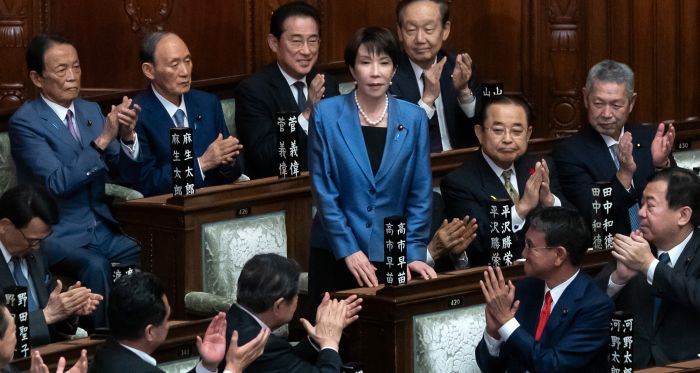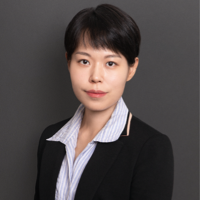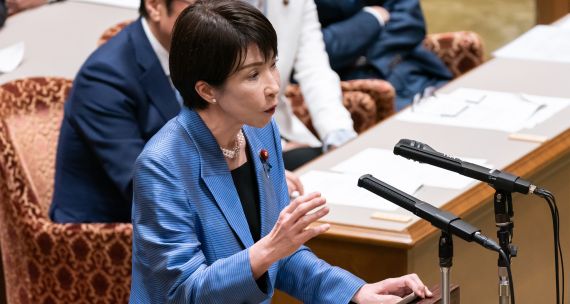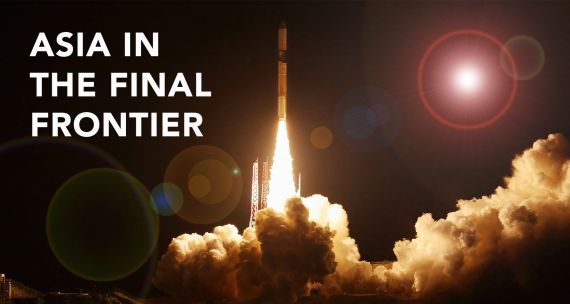The Takeaway
On October 21, Japan’s Diet — the country’s parliament — elected hardline conservative Takaichi Sanae as the country’s first woman prime minister, following her victory in the Liberal Democratic Party (LDP) leadership race earlier this month. Her ascension marks a historic milestone in a country where women occupy just 16 per cent of seats in the Diet. The day before Takaichi’s win, the LDP and the centre-right conservative Japan Innovation Party (Ishin no Kai) signed a coalition agreement, giving Takaichi a path to govern.
Takaichi’s rise signals a shift to the right in Japanese politics. The weakening of the LDP by recent electoral losses, ongoing scandals, and reliance on a fragile coalition make governing under her leadership an especially demanding task.
In Brief
- Takaichi won through a simple majority in both houses: 237 of 465 votes in the lower house and 125 out of 248 in the upper house. Her path to Japan’s top office was thrown into doubt when the centrist Komeito party ended its 26-year-old coalition with the LDP days before the parliamentary vote.
- The LDP–Ishin coalition agreement reflects Ishin’s demands, including constitutional revision (notably, revising Article 9, which renounces war and prohibits Japan from maintaining traditional armed forces), passage of an anti-espionage law, and tighter restrictions on land purchases by foreigners.
- Takaichi’s cabinet picks thus far suggest she is trying to strike a balance between loyalty to the faction of the late prime minister Abe Shinzo — her key power base — and broader party unity. Many of her senior appointees align with the conservative wing of the LDP. For example, Katayama Satsuki, the new finance minister, is known for her pragmatic but fiscally conservative approach, which complements Takaichi’s more expansionary instincts. Koizumi Shinjiro, Takaichi’s former rival in the LDP leadership race and a former farm minister, was appointed defence minister. Akazawa Ryosei, who handled U.S. tariff negotiations under previous administrations, takes over as trade minister, signalling policy continuity in Japan’s external economic relations.
Implications
Domestically, Takaichi’s leadership suggests conservative retrenchment in response to LDP weakness. Facing consecutive electoral setbacks, the party chose Takaichi’s hardline credentials to prevent a defection among their supporters to the far-right Sanseito. However, the result of this move was a fracturing of the erstwhile centrist coalition.
The new LDP–Ishin coalition gives Takaichi a more stable legislative base, but not enough for a majority in the Diet. Ishin shares “many common views” with the LDP, particularly on national security and deregulation. Both parties advocate for a substantial increase in defence spending to reach Japan’s target of two per cent of GDP by the late 2020s. They also back a more assertive security posture amid rising regional tensions, including a potential Taiwan contingency and North Korea’s missile program. Strengthening the U.S.–Japan alliance and expanding Japan’s defence capabilities are expected to remain key priorities under Takaichi.
However, the stability of the coalition is uncertain, as Ishin was not given any ministerial roles in Takaichi’s cabinet, at least for now. In addition, while concern about national security is the glue holding this coalition together, there are points of friction, especially around Ishin’s demands to reduce the number of Diet seats and tighten the rules governing political finance. If Ishin feels that its interests are not being adequately addressed, it could walk away from the partnership.
On foreign policy, Takaichi is expected to maintain Japan’s existing diplomatic orientation — pro-U.S., and proactive in the Indo-Pacific. She aligns with the Abe/Kishida-era focus on a Free and Open Indo-Pacific Strategy and ‘minilateral’ partnerships such as the Quad.
Relations with China, however, will require delicate management. Beijing reacted cautiously to Takaichi’s prime ministership, urging Tokyo to “honour its political commitments” on historical and Taiwan-related issues—a reference to Japan’s apologies for wartime aggression and its adherence to the One China policy. Takaichi’s visit to Taiwan in April, when she met President Lai Ching-te, only adds to China’s wariness.
South Korea, meanwhile, signalled openness to continuing the two countries’ bilateral “cooperative partnership” despite concerns about Takaichi’s nationalist inclinations. Notably, Takaichi refrained from visiting the controversial Yasukuni Shrine prior to upcoming summits — seen as a gesture of restraint.
What’s Next
1. U.S.–Japan summit will test Takaichi’s leadership
U.S. President Donald Trump’s upcoming visit to Tokyo in late October will be Takaichi’s first major diplomatic engagement. Analysts expect she will push for a comprehensive security agenda beyond trade, given her pro-defence stance. This could include deeper U.S.–Japan military co-operation and discussions about burden-sharing, leveraging her commitment to increasing defence spending.
She is also expected to continue cultivating like-minded partnerships through frameworks such as the Quad, reinforcing Japan’s current approach to the Indo-Pacific. In late October, she will represent Japan at the Association of Southeast Asian Nations summit in Malaysia and the Asia-Pacific Economic Cooperation summit in South Korea, where she may indicate her priorities on regional economic and security issues.
2. Canada-Japan relations: shared interests
Canada-Japan ties are expected to remain robust under Takaichi. Japan is Canada’s fourth-largest merchandise trading partner, and both are key players in the Comprehensive and Progressive Agreement for Trans-Pacific Partnership (CPTPP). They also share a commitment to a rules-based Indo-Pacific order.
Takaichi’s government is expected to maintain momentum in areas such as energy, technology, and security. Japan sees Canada as an alternative to key Middle East and Russian commodities, including as a critical supplier of LNG, oil, and critical minerals, including lithium and rare earths. Joint projects on clean energy and resources (e.g. hydrogen, lithium, rare earths) are also being discussed, according to the Canadian Chamber of Commerce in Japan.
Takaichi has appointed Iida Yuji—former vice-minister for economy, trade, and industry—as Executive Secretary for Political Affairs, in charge of both political and bureaucratic aspects of the Cabinet’s portfolio. Known for his decarbonization efforts under former prime minister Kishida Fumio, Iida’s appointment could further align Tokyo and Ottawa’s climate and tech agendas.
A bilateral meeting between Takaichi and Canadian Prime Minister Mark Carney is likely to occur during the upcoming APEC summit in South Korea. Discussions could centre on supply-chain security, green tech, and artificial intelligence governance, potentially leading to new bilateral initiatives.
• Edited by Vina Nadjibulla, Vice-President Research & Strategy, Erin Williams, Director, Programs, and Ted Fraser, Senior Editor, APF Canada






